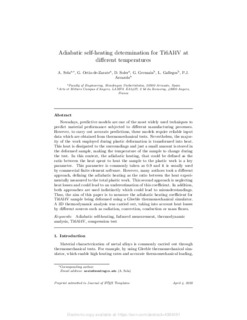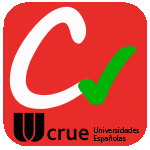Título
Adiabatic self-heating determination for Ti6Al4V at different temperaturesFecha de publicación
2023Otras instituciones
Arts et Métiers Campus d’Angers, LAMPAVersión
Preprint en revisiónTipo de documento
ArtículoArtículoIdioma
InglésDerechos
© 2023 ElsevierAcceso
Acceso embargadoFin de la fecha de embargo
2025-01-12Versión de la editorial
https://doi.org/10.1016/j.ijheatmasstransfer.2022.123747Publicado en
International Journal of Heat and Mass Transfer V. 204. N. articulo 123747Editorial
ElsevierPalabras clave
Adiabatic self-heating
Infrared measurement
Thermodynamic analysis
Ti6Al4V ... [+]
Infrared measurement
Thermodynamic analysis
Ti6Al4V ... [+]
Adiabatic self-heating
Infrared measurement
Thermodynamic analysis
Ti6Al4V
Compression test [-]
Infrared measurement
Thermodynamic analysis
Ti6Al4V
Compression test [-]
Resumen
Nowadays, numerical models are one of the most widely used techniques to predict material performance subjected to different manufacturing processes. However, to obtain accurate predictions, these mod ... [+]
Nowadays, numerical models are one of the most widely used techniques to predict material performance subjected to different manufacturing processes. However, to obtain accurate predictions, these models require reliable input data from thermomechanical tests. Nevertheless, during the test performance the material is self-heated due to a phenomenon known as adiabatic self-heating. Despite the proven relevance of a proper characterization, adiabatic self-heating is not properly taken into account during thermomechanical tests. In addition, in the literature, two different definitions were found under the umbrella of adiabatic-self heating. On the one hand, it could be defined as the ratio between the heat spent to heat the sample to the plastic work, value commonly taken as 0.9. On the other hand, many authors define the adiabatic heating as the ratio between the heat experimentally measured to the total plastic work. This second approach, although seems easier, is neglecting heat losses. These two different approaches could lead to misunderstandings once this parameter is implemented in the models. This paper aims to clarify this issue. Moreover, the techniques found in literature aiming to measure this parameter are usually based on 2D approaches at low temperatures. In this paper, a 3D methodology to measure adiabatic self-heating is presented which considers all possible heat losses (conduction, convection, radiation and mass flux) through infrared measurements and Digital Image Correlation (DIC) technique. The adiabatic self-heating was measured for a widely used alloy (Ti6Al4V) obtaining promising results. [-]
Sponsorship
Gobierno de EspañaID Proyecto
info:eu-repo/grantAgreement/GE/Convocatoria 2018 de proyectos de I+D+i «Retos Investigación», del Programa Estatal de I+D+i Orientada a los Retos de la Sociedad, en el marco del Plan Estatal de Investigación Científica y Técnica y de Innovación 2017-2020/RTI2018-095463-B-C21/ES/Ingeniería de Superficies a través del mecanizado enfocado a materiales empleados en la aeronáutica y la automoción: proceso de mecanizado enfocado al materialColecciones
- Artículos - Ingeniería [763]





















